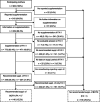Adherence to recommendations for nutrient supplementation related to pregnancy in Germany
- PMID: 37701189
- PMCID: PMC10494575
- DOI: 10.1002/fsn3.3482
Adherence to recommendations for nutrient supplementation related to pregnancy in Germany
Abstract
Supplementation of certain micronutrients is recommended to ensure their adequate supply during pregnancy and lactation. In Germany, this applies particularly to folic acid and iodine. There is no nationwide data on adherence to the supplementation guidelines. The aim of this cross-sectional study was to determine the prevalence and predictors of the recommended supplementation of both folic acid and iodine in mothers of a nationwide birth cohort. Data on supplementation, before, during, and shortly after pregnancy, were collected retrospectively 14 days postpartum in a sample of 962 mother-infant pairs participating in the second nationwide study on breastfeeding and infant nutrition in Germany, called "SuSe II" (2017-2019). Folic acid and iodine supplementation were classified as recommended according to the German guidelines if supplementation was provided for both essential periods: for folic acid before and during pregnancy and for iodine during pregnancy and lactation. Univariable tests and multivariable logistic regression analysis were performed. The vast majority of mothers did not adhere to the recommendations, with only 36.2% supplementing folic acid and 31.9% supplementing iodine during the recommended periods, and only 15.2% adhering to the recommendations for both nutrients. Main predictors of adherence to recommendations of both nutrients were lifestyle attributes and nutrition-related intentions like previous breastfeeding experience and breastfeeding intentions, but not common sociodemographic characteristics. The data suggest widespread dissemination of the time-specific recommendations covering the entire period from preconception to lactation that could help to sensitize women and healthcare providers.
Keywords: dietary supplements; folic acid; iodine; lactation; micronutrients; pregnancy.
© 2023 The Authors. Food Science & Nutrition published by Wiley Periodicals LLC.
Conflict of interest statement
The authors declare that they do not have any conflict of interest. MK and ES were members of the German National Breastfeeding Committee between 1994 and 2021 (MK) and between 2008 and 2021 (ES).
Figures
Similar articles
-
Poor adherence to folic acid and iodine supplement recommendations in preconception and pregnancy: a cross-sectional analysis.Aust N Z J Public Health. 2016 Oct;40(5):424-429. doi: 10.1111/1753-6405.12552. Epub 2016 Aug 14. Aust N Z J Public Health. 2016. PMID: 27523027
-
Recommendation and intake of dietary supplements periconceptional and during pregnancy: results of a nationwide survey of gynaecologists.Arch Gynecol Obstet. 2023 Dec;308(6):1863-1869. doi: 10.1007/s00404-023-07167-6. Epub 2023 Sep 16. Arch Gynecol Obstet. 2023. PMID: 37715805 Free PMC article.
-
Maternal adherence with recommendations for folic acid and iodine supplements: A cross-sectional survey.Aust N Z J Obstet Gynaecol. 2018 Feb;58(1):125-127. doi: 10.1111/ajo.12719. Epub 2017 Oct 9. Aust N Z J Obstet Gynaecol. 2018. PMID: 28990157
-
Benefits of docosahexaenoic acid, folic acid, vitamin D and iodine on foetal and infant brain development and function following maternal supplementation during pregnancy and lactation.Nutrients. 2012 Jul;4(7):799-840. doi: 10.3390/nu4070799. Epub 2012 Jul 24. Nutrients. 2012. PMID: 22852064 Free PMC article. Review.
-
Breastfeeding and maternal and infant iodine nutrition.Clin Endocrinol (Oxf). 2009 May;70(5):803-9. doi: 10.1111/j.1365-2265.2008.03442.x. Epub 2008 Oct 6. Clin Endocrinol (Oxf). 2009. PMID: 19178515 Review.
Cited by
-
Replacing cow's milk with plant-based drinks: consequences for nutrient intake of young children on a balanced diet in Germany.J Health Popul Nutr. 2025 Mar 28;44(1):93. doi: 10.1186/s41043-025-00836-z. J Health Popul Nutr. 2025. PMID: 40155986 Free PMC article.
-
Iodine supplementation for pregnancy in Portugal: identification of nutritional composition of iodine containing supplements and characterization of pharmacy dispenses from 2008-2022.Front Endocrinol (Lausanne). 2025 May 22;16:1582610. doi: 10.3389/fendo.2025.1582610. eCollection 2025. Front Endocrinol (Lausanne). 2025. PMID: 40475998 Free PMC article.
References
-
- Arbeitskreis Folsäure und Gesundheit . (2023). AKF: Information . https://www.ak‐folsaeure.de/positionen/ accessed on 2/5/2023
-
- Arbeitskreis Jodmangel . (2023). AKJ: Information . https://jodmangel.de/der‐arbeitskreis‐jodmangel/ accessed on 2/5/2023
-
- Aronsson, C. A. , Vehik, K. , Yang, J. , Uusitalo, U. , Hay, K. , Joslowski, G. , Riikonen, A. , Ballard, L. , Virtanen, S. M. , Norris, J. M. , & TEDDY Study Group . (2013). Use of dietary supplements in pregnant women in relation to sociodemographic factors – a report from the environmental determinants of diabetes in the young (TEDDY) study. Public Health Nutrition, 16(8), 1390–1402. 10.1017/S1368980013000293 - DOI - PMC - PubMed
LinkOut - more resources
Full Text Sources


